
- The fire that came down from heaven
- The Alfândega Gargoyles
- A ghost in the convent
- A king buried in Rua da Carreira
- The painting that escaped Hitler
- The hidden fortress
- A peculiar procession
- Angústias
- From São Sebastião to Chafariz (without losing the boots)
- Bullfights and games
- The heart of Funchal
- The chains of peace
- Apparitions in the Church of Santo António
- The Chapel of Bones
- The resistance gate
- Pico da Cruz Battery
- The transferred temple
- Orchestrophone
- The Passos
- A game at sea
- Europe’s largest bookstore
- Saga of an African princess
- The garage chapel
- The walls of Pena Hill
- Funchal’s anti-aircraft battery
- The smallest chapel in the world
- The American Railway
- The Paiol
- Jewish Cemetery of Funchal
- The patroness and her fashion
- A prison in the Cathedral’s tower
- Waiting for the dragon
- The Vapor
- The Race Course
The fire that came down from heaven
Rua da Queimada de Cima and Rua da Queimada de Baixo owe their name to a strange event that marks the beginnings of Funchal’s urban narrative. Between July 26th and 27th, 1593, at a time when most houses in Funchal were built on planks, a mysterious “fire from heaven” descends on the city, causing a conflagration that spreads from Rua do Sabão to the walls of the São Lourenço Fortress. Gaspar Frutuoso writes of 154 houses burned to the ground and more than 5000 sugar loaves destroyed. In the days before the calamity, the island had been plagued by a wave of extreme heat and strong wind. “There was no living person able to leave the house or open the window”, because “the wind was such that it seemed to burn the bones”, described a witness. The enigmatic atmospheric incandescence, which maintained its presence in the firmament, and was of different nature from that of a thunderstorm ray, had arisen sometime before rushing over the city. The strange designation of the streets and the memory of the calamity would remain.
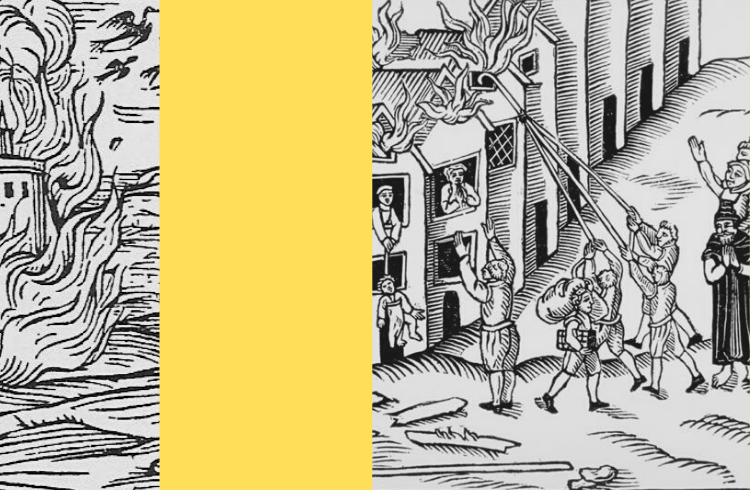
The Alfândega Gargoyles
Imperceptible to those who circulate through the usual bustle of the narrow street below, peeking from the top of the old Manueline building of the Alfândega Nova of Funchal, the current seat of the Legislative Assembly of the Autonomous Region of Madeira, four gargoyles share the weight of five centuries fulfilling the old function of draining the waters. They are rare remnants of a strange medieval imaginary, preserved in this northern facade of one of the oldest buildings in the city. These specimens are of particular interest, not only for their rarity, size, and good condition but above all for the quality and nobility of their sculptural work: the grotesque human figures and animals in a challenging pose stimulate the imagination and awaken a kind of epidermal memory of the city, in which time becomes a space where we can meet the legends long-forgotten.

A ghost in the convent
In the second decade of the 16th century, a strange episode (reported by several chroniclers) occurs in the Santa Clara convent. While reading the divine offices during the night, the nuns started hearing moans and sighs, felt the drag of furniture and the oscillation of walls. The recurring phenomenon caused panic among those religious women. It is said that João Rodrigues Burio, the convent’s schoolmaster, decided to confront the reason for such abnormal activity. One night, when the usual prayers were over, he hid in the church and waited. It is said that, in fact, he encountered a ghost and confronted it – the lost soul of a reputed man of lineage, recently buried in that sacred precinct and condemned to wander there for having doubted his faith at the time of death. The loneliness and rigor of monastic life may have claimed its price and sparked the power of the imagination… perhaps. It is certain, however, that Gaspar Frutuoso, Frei Manuel da Esperança, and Henrique de Noronha allude to this episode, explaining that serenity only returned after the dead man’s body was dug up. In the place of the new grave, outside the walls, in a hill overlooking the convent, a cross was placed: a procedure that, according to what is said, will have originated the name by which that place is known today: Cruzes (Crosses).

A king buried in Rua da Carreira
George Oruigbiji Pepple, known as king Perekule VII, was a monarch of the extinct Kingdom of Ubani, in present-day Nigeria. He ascended to the throne on September 30, 1866, at the age of 17, having been deposed on December 14, 1883, following internal opposition due to his proximity to the United Kingdom and his embrace of the Christian religion (which had impelled him the unpopular measure of banning the worship of iguanas in his domains). In 1886 he managed to regain power, thanks to the intervention of his British allies, but died shortly after, two years later, in Funchal. King George is buried in the British Cemetery of Madeira, which had its original main entrance in Rua da Carreira, a place that in the words of another famous occupant, scientist Paul Langerhans (discoverer of the insulin-producing mechanism and the Langerhans cell), was “a good place to rest…”
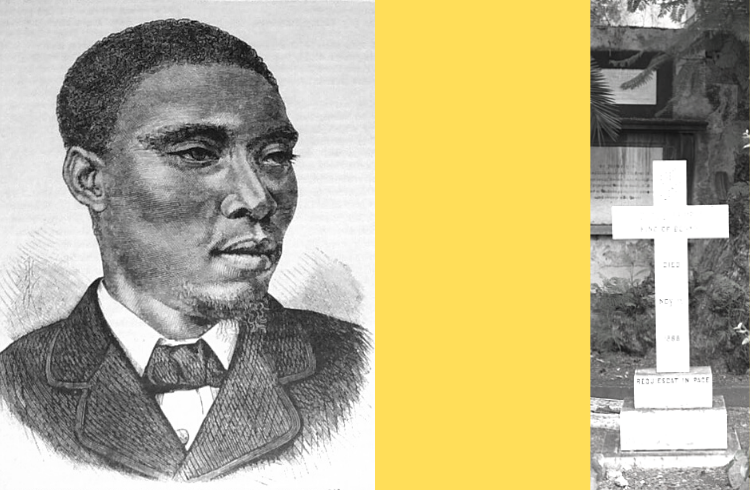
The painting that escaped Hitler
A Flemish triptych, representing the Descent from the Cross, attributed to the painter Gerard David of Bruges, had a troubled life. Painted between 1518 and 1527, the work was commissioned by Jorge Lomelino and initially intended for the Convent of Nossa Senhora da Piedade in Santa Cruz, where it remained until it was transferred to a chapel at the Cloister of São Francisco, in Funchal. With the demolition of the latter, the work ended up in a storeroom of the Santo António da Serra church, where it was acquired by Major Américo Olavo, in 1915. Stored at Quinta da Palmeira for some time after that, it was later sent for restoration in Lisbon. Upon the Major’s death, the painting is sold to the Austrian Adolf Weiss and is shipped to Vienna, where it is again restored and studied by Max Friedelander, who attributes it to Gerard David. The alleged authorship and the quality of the work arouse the interest of Marshal Hermann Göring (notorious for the campaign of theft and forced purchase of works of art in benefit of the Führer’s private collection), who presents Weiss with an acquisition proposal. However, in the middle of the Second World War, the triptych is sent to Bern, Switzerland, thus escaping Nazi greed. In 1944 it was bought by the Portuguese State, returning to the country in 1954 by diplomatic transport. It can be seen at the diocesan museum, the Museu de Arte Sacra, in Funchal.

The hidden fortress
Composing the defensive line of Funchal’s coastline, the almost forgotten Forte dos Louros takes on a different character from other more prominent fortifications. It was commissioned during the 17th century by the merchant Diogo Fernandes Branco, on the steep hill overlooking the Ribeira de Gonçalo Aires, as a private stronghold. Its declared objective was to defend the economic interests of the Fernandes Branco family, by protecting the landing pier that served its properties at the Louros site. It had a tall wall that supported a rectangular square with a capacity for five canons. Diogo Pereira Forjaz Coutinho, Governor of Madeira in the late 17th century, intended to install a silk factory there, a project that was never materialized. The old fortification, deactivated for more than two hundred years, is now in ruins and almost camouflaged by the tangle of new buildings and the sovereignty of the brushwoods, passing unnoticed by those who do not seek it…

A peculiar procession
In the year 1521, with the plague raging in the city, João Gonçalves da Câmara and the Funchal’s Senate decided to appeal to the celestial patronage to put an end to the scourge. In a drawing that included the names of the twelve apostles, Saint John the Baptist, the Virgin Mary, and even Christ himself, the choice fell upon one of Jesus’ lesser-known disciples: Saint James the Minor. Once the heavenly clinician was determined for such a serious illness, the full authority of the Chief Guard of Health, normally in charge of taking measures during health crises, ceased. According to the reports, the extreme remedy proved to be effective on the very day of the first prayer procession, on May 1st, 1521. As a sign of recognition the Senate of Funchal started to promote, annually, the feast and procession of the Vow of St. James, with pomp identical to that of the Corpus Christi ceremony and with the merriment worthy of… a carnival parade? Well, yes. The members of the procession had the obligation to perform burlesque dances, entrusted to the choreographic care of the groups representing the 24 traditional crafts and enriched with the presence of giant dolls. In fact, the non-execution of the dances or the omission of the presence of the usual props was severely censored with the application of fines, duly registered in the official books of record.
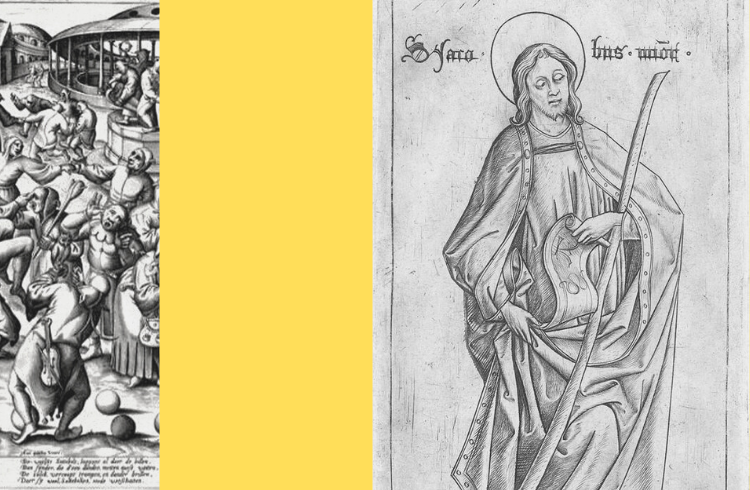
Angústias
Anyone who visits the Parque de Santa Catarina will not fail to be dazzled by the beautiful panorama that this pleasant green area, at the foot of the old Chapel of Santa Catarina, offers. What will probably not cross anybody’s mind is the fact that much of that extensive lawn was once a burial site. In this space operated, for a century, the first public cemetery of Funchal, known as Angústias (due to its proximity to the villa with the same name, known today as Quinta Vigia), installed in 1837 and transferred between 1939 and 1944 to the parish of São Martinho. The original carved stonework gate of this cemetery can still be seen in São Martinho, where it was reassembled. António Gil Gomes, a renowned Madeiran writer and author of the “Compilation of Principles of Rational Philosophy”, had his grave denied in this cemetery for having renounced the Catholic faith – even so, he was buried in the present location of Parque de Santa Catarina, but in a place once occupied by the pigsty of the cemetery guard.

From São Sebastião to Chafariz (without losing the boots)
If you walk by Largo do Chafariz (Square of the Fountain) you will have no obvious difficulty understanding the reason for that name. There is a splendid fountain right in the middle of the little square… But it was not always so. The surrounding toponymy offers us some clues. Largo de São Sebastião was the oldest designation, indeed that was the place where a chapel dedicated to Saint Sebastian, the city’s secondary patron, once stood. Of that old chapel, demolished in 1803, only the name of the nearby alley remained. Then emerged the Largo do Mercado (Square of the Market), a name that never gained much sympathy or popularity (for many people it remained the Largo de São Sebastião). Sellers from all parts of the island gathered there with their vegetables, fruits, and animals. It was a specially busy place at Christmas time. Later, in the early 20th century, a very popular boot market appeared, which dominated the space. It was, however, the fountain placed there by the Câmara in 1826 to determine the final and current name of this place, a perfect symbol of the historical density of this city’s small recesses.

Bullfights and games
The playful moment has always been part of Madeiran community life. In the 16th century Funchal there was certainly time and space for this lighter side of existence. Curiously, the lightness of the practices did not equate to a search for more obscure spaces, on the contrary. Those enjoyments took place in the noble core of the city, right next to it’s more sacred buidings, punctuating the festive days and the great celebrations with an appreciated relaxation shared in a prominent setting. Bullfighting and cane games in front of the Cathedral and a ball game called pélas next to the houses of the Paços do Concelho: all in a sort of odd square that linked those buildings, the old Terreiro da Sé. The celebration of this public entertainment cemented the identity of the new city. Only the popular jogo da bola, a kind of medieval bowling, would be played elsewhere, in the poorer neighborhood of Santa Maria, where the fishermen lived.

The heart of Funchal
Sent in 1486 by Dom Manuel, then Duque de Beja, to be raised near the houses of the Câmara, the Pelourinho (pillory) of Funchal will eventually be placed on the other side of the Santa Luzia river, near the old church of Nossa Senhora do Calhau. The choice of location is quite curious: this element marked the urban center – we have, therefore, as the chosen heart of this new urban reality a place surrounded by the banks of two streams, in between the two nuclei of settlers. It’s primary mission, like all the pillories, was to symbolize the power and authority of a distant king. As a punishment instrument, however, it took on a secondary role in places where there was no challenge to the monarch’s sovereignty, being even more connoted with a certain idea of municipalism and local power. Even so, in 1835 the demolition of the old symbol was ordered on grounds that it was “an emblem of feudal times”. The stones were sold at public auction, and some fragments would eventually be preserved in the archeological park of Quinta das Cruzes and later remounted in the replica that was built in the original location of this landmark, at Largo do Pelourinho.

The chains of peace
On the morning of December 3rd, 1916, during the First World War, there was an attack by the German navy on the city of Funchal, carried out by the submarine U-38, sinking a Portuguese transport barge and three foreign ships: the British submarine cable launcher “Dacia”, the French submarine carrier “Kanguru”, and the “Surprise” warship, also French. In this first attack, 8 Madeirans and 33 crew members of the Allied ships died. Another attack would take place thirteen days later, with no victims. In 1917, on December 12, a new bombing of the city occurred, causing the death of 5 people and the partial destruction of the church of the Convento de Santa Clara. Following these dramatic incidents, the monument to Our Lady of Peace is built, overlooking the city. Those who visit this space, at Terreiro da Luta, will be able to observe a titanic rosary that surrounds the pedestal where the sculpture of the Virgin Mary rises – the peculiar artifact was made with stones from the Santo António river and with the currents of ships sunk in the attack of 1916, having been transported by 300 men in a procession carried out from the port of Funchal, on November 1st, 1927.
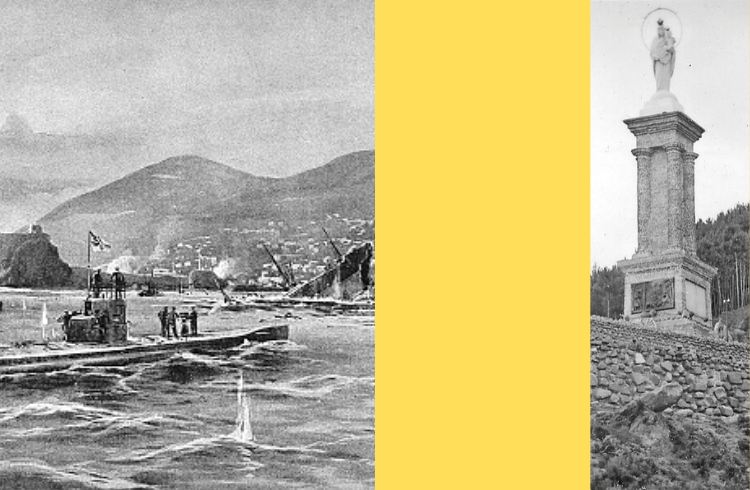
Apparitions in the Church of Santo António
According to the account of Father João Prudêncio da Costa, confessor of Mother Virgínia Brites da Paixão, this mystical woman received several revelations of a supernatural character. The cleric narrates a cycle of successive apparitions to the nun, starting with a vision of Christ, on April 16, 1913, in the Church of Santo António. There would be reports of other apparitions of Jesus and the Virgin Mary, and the sending of messages to Pope Benedict XV. The revelations made by Mother Virgínia had a decisive influence on the building of the first temple in the world dedicated to the Immaculate Heart of Mary, in the parish of Boaventura, and in the subsequent construction of a church to the Immaculate Heart of Mary in Funchal, preceding the well-known phenomenon of Fátima in many years. In the Santo António church, the place of the reported mystical experiences was marked with a painting by Luís António Bernes, made in 1921 and based on a sketch by Mother Virgínia executed by order of Christ himself.

The Chapel of Bones
Many Madeirans will have heard of the disappeared Convento de São Francisco that once dominated the center of Funchal in the space that today is occupied by the public gardens, the Jardim Municipal; what probably does not remain in the city’s memory is the existence, in one of the wings of this convent, of a macabre chapel that attracted the curiosity of countless visitors. Like the famous structure with the same name in Évora, the Capela dos Ossos of Funchal had walls completely covered with human bones, the only decorative elements, besides the altarpiece of Saint Michael, the thousands of tibias and skulls that, in a carefully symmetrical arrangement, filled all surfaces, even the ceiling, as we can see in an engraving from the late 18th century by John Barrow, who would describe the morbid place as a “chamber of skulls”, estimating that they were more than three thousand. The chapel disappeared with the demolition of the convent in the 19th century, but we can still see in the Jardim Municipal the old stone coat of arms that topped the building’s entrance.

The resistance gate
The São Paulo Gate, demolished in 1839, was one of the main entrances of Funchal, to the west of the urban center, at the end of Rua da Carreira, near the chapel of São Paulo. The place marks a crucial moment: the day when the inhabitants of Funchal were called to make the ultimate sacrifice for the defense of their city when the French corsairs attacked it in 1566. Having landed at Praia Formosa, Bertrand de Montluc, at the head of a thousand and two hundred men, tried to penetrate the city through this point that presented itself as the main access in the natural path of the invading forces. There he encountered the first resistance, being forced to try to enter elsewhere. The pirates would eventually defeat the Portuguese forces in an assault on the São Lourenço fortress, and plunder the city for sixteen dreadful days. Close to the place where the gate stood, it is still possible to observe traces of the ancient wall that for centuries after that episode served as a terrestrial defensive barrier.

Pico da Cruz Battery
In 1940, at Pico da Cruz, the Army installed the Independent Battery for the Defense of the Coast no. 2, a unit which was equipped with three Krupp artillery guns model 1898, made in Germany, caliber 15 cm, to protect Funchal against the possibility of an act of aggression in the middle of World War II. The place was chosen for its visibility and firing range over the two main landing points: Funchal Bay and Praia Formosa. The spaced distribution of the impressive pieces along a line on the south side of the elevation follows a plan that includes vast underground galleries, allowing communication between the various platforms and providing enough space for the accommodation of more than a hundred military personnel. Complementing this structure is a higher system of observatories, also underground. This impressive fortification remained operational until 1996 and is currently in perfect condition.

The transferred temple
There was in the primitive building of the Misericórdia of Funchal, today the headquarters of the Regional Government of Madeira, a temple dedicated to Saint Elisabeth, the main chapel of the hospital of Santa Isabel that operated there. In the 30s and 40s of the last century, following a plan for urban reorganization and the transfer of the hospital to the Marmeleiros site, the partial demolition of the building took place, which dictated the complete dismantling of the 17th-century chapel. Despite the vicissitudes, the temple would largely survive: the stonework of the porch and the interior balconies, the tiles, the painted ceiling and the monumental altarpiece in gilded woodwork have been completely re-assembled in the new church of the Sacred Heart of Jesus in Boa Nova, where it remains today.

Orchestrophone
In the Museum of Quinta das Cruzes there is a rare relic of the Belle Époque: the orchestrophone. This automated musical instrument, built in 1900 by Limonaire Frères, in France, belonged to the Viscount of Cacongo, João José Rodrigues Leitão, who acquired it at the Paris International Fair. Its operation mode is based on the reading of perforated cards that regulate the various sound production systems, once the mechanism is activated by the use of a simple crank. That allowed its frequent use, with no need for operators with particular technical or musical knowledge. As its name implies, the result is the harmonious and almost perfect imitation of an orchestra playing a musical piece, mostly waltzes or polkas, according to the taste of the time. The mechanical device is complemented with beautiful decoration and automata in perfect condition.
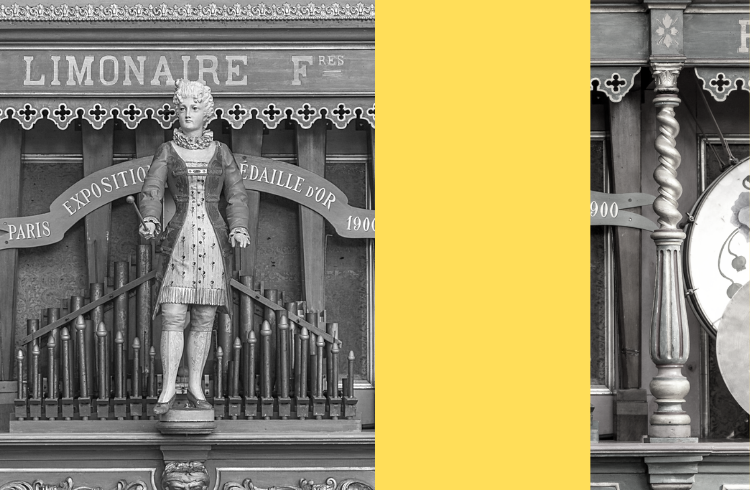
The Passos
One of the highlights of the city’s ancient devotional life was the Passos procession. The religious cortege, which left the Igreja do Colégio towards the Igreja de Santa Maria, evoked the last moments of Christ’s life, portrayed in five niches along the streets of Aljube, Pelourinho and Santa Maria. Each of these niches, called Passos da Paixão, duly identified with stonework in a model similar to that used in other religious structures of that time, had several paintings evocative of a specific torment of Jesus’ route to Calvary. The arrival of the statue of Senhor dos Passos at the threshold of each oratory caused a stop in the procession. In the church of Santa Maria, before returning to the Colégio, there was a great scenic representation of the crucifixion that only ended at nightfall. Of the five Passos da Paixão only two survived the changes that the 20th century brought to the urban fabric: Passo do Pelourinho and Passo de Santa Maria.

A game at sea
In 1922 the Madeiran League of Water Sports was founded. The championship had the participation of five clubs: Clube Sport Marítimo, Grupo Desportivo Nacional, Club Sports da Madeira, Império Foot-ball Club, and União Foot-ball Club. The practice soon gained popularity, reaching a large audience. This is how the city obtains its most peculiar competition space, in the bay of Funchal, next to Ilhéu da Pontinha, at sea. In 1922, at the end of the first sporting season, Marítimo and Império were tied, so it was necessary to have a final game to decide the championship, with the ticket revenue for that match amounting to 53 escudos. It will be the Império Foot-ball Club to consecrate itself, by three balls to one, Madeira’s first water polo champion.
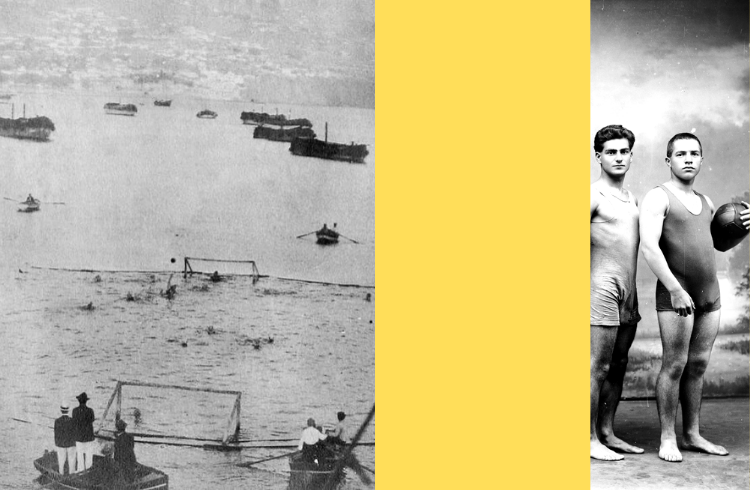
Europe’s largest bookstore
Founded in 1886 by Jacintho Figueira de Sousa, Livraria Esperança was the first establishment in Funchal to have the exclusive function of selling books. It is now the fourth generation of the same family to manage this space that remains faithful to a particular way of welcoming those who seek to immerse themselves in the world of reading, traversing the labyrinthine corridors between clotheslines of life, history, and dream. There are more than 100 thousand copies, displayed on 1200 square meters of shelves: cover books always on display, in a manner almost as dense as the knowledge celebrated there. It has become an unlikely meeting place for generations, opening the doors of its colossal treasure to the curiosity of the city and those who visit it. Livraria Esperança is the largest bookstore in Europe and the second-largest bookstore in the world.

Saga of an African princess
Sara Forbes Bonetta, Aina originally, was a Nigerian princess who was a member of the Egbado royal family, taken prisoner and enslaved by king Ghezo, who had her parents murdered. In 1850, at the age of seven, she was sent as “a gift from the king of blacks to the queen of whites”, Victoria of the United Kingdom, who had already given her royal assent to the decree for the extinction of slavery in 1834. Queen Victoria and Prince Albert, impressed by the child’s intelligence, would end up adopting her as a goddaughter. In 1862 she married the African businessman and philanthropist Captain James Pinson Labulo Davies. Her first daughter, born in 1863, was named Victoria. She will always maintain a very close relationship with the Queen, with whom she corresponded frequently. After contracting tuberculosis, she sought treatment in Madeira, taking up residence in Funchal where she died on August 4th, 1880, at the age of 37. She is buried in the British cemetery.

The garage chapel
Largo da Saúde owes its peculiar name to the 17th-century chapel dedicated to Nossa Senhora da Saúde (Our Lady of Health). However, anyone who passes by that place may be excused for thinking that the small chapel no longer exists. Built in 1559 by order of Pedro de Valdevesso, this reasonably sized private chapel was attached to the manor known as Quinta da Vinha where, in 1879, the Welshman Henry Miles installed the first brewery in Madeira, Atlantic Brewery (which also produced soda water and lemonade). The private nature did not prevent the confluence of many devotees to this place of worship which, by its very invocation, lent itself to the most varied vows from the faithful. A curious fact is that this religious space possesses the only private tomb crypt in Madeira. The chapel continues to exist, amputated in its rich heritage but still standing, surrounded by an industrial façade, hidden in a garage.

The walls of Pena Hill
Ordained by the 1572 Fortification Regiment, the walls of Morro da Pena are remnants of Funchal’s protective belt, built under the guidance of Mateus Fernandes. This segment followed the Ribeira de João Gomes, escorting the growing city that had climbed over the river of Santa Luzia, the limit of the Manueline nucleus, towards the old settlement of Santa Maria, initially excluded from the walled perimeter. The defensive system anticipated the construction of a gigantic fortress between the hill of Pena and the Calhau de Santa Maria that would work, alongside the Pico Fortress, as a closure of the walled line – a project that would remain unrealized. The walls now visible in Morro da Pena are one of the oldest and largest traces of the succession of buildings that formed the so-called “city curtain”.
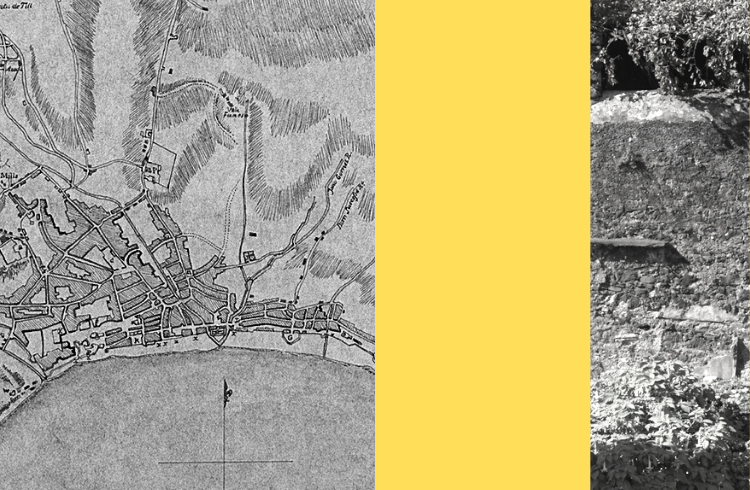
Funchal’s anti-aircraft battery
In Pico de São Martinho, on the slope that faces the city center, a fixed battery of anti-aircraft artillery with four British Vickers pieces was installed in 1942, complementing the fixed battery of Palheiro Ferreiro, on the other side, allowing a cross defense fire over any attacking aircraft. The two military positions, which were built during the escalation of World War II, were intended to ensure a defense suitable to Funchal’s strategic value (in case of aggression, or Portugal’s entry into the conflict). Large lighting projectors and other surveillance equipment watched over the skies of the Madeiran capital. The Palheiro Ferreiro anti-aircraft battery was dismantled in 1994, remaining only the three canons of Pico de São Martinho, recently restored.

The smallest chapel in the world
Often mentioned as the smallest chapel in the world, the Capela das Almas Pobres, built in 1781 next to a rock, in Travessa das Capuchinhas, by order of Roque de Araújo, may well claim another title – that of having, as a beginning, an episode that in the eyes of modern culture could well be classified as a lucky “haunting”. According to the traditional narrative, Roque de Araújo, a busy trader that often passed by late at that place, was the target of several attack plans that would never be attempted for an understandable reason: the assailants found the lucky man always accompanied, despite the man’s asserting that he had always been there alone… The truth is that the theft did not occur and Roque de Araújo had no hesitation in crediting the souls of Purgatory with the imperceptible company that had preserved him.

The American Railway
Following the opening of the first two sections of the Caminho de Ferro do Monte, in 1896 begins the operation of the lesser-known American Railway, which connected Praça da Constituição (currently Largo da Restauração) to Pombal station. While on Monte’s Railroad the service was totally mechanized, taking advantage of a steam locomotive on a rack railway, in this second public transport the system used was one of animal traction on rails: an open carriage pulled by three horses or mules on a rail embedded in the pavement with a two-foot gauge. Three of these cars, popularly called “Americanos” (Americans), were in the public’s service for two decades. The American Railway went into decline with the arrival and popularization of the motorcar, and the operation was definitively suspended on January 29, 1916.

The Paiol
Planned as a way to withdraw from the urban core the dangers inherent in the storage of large amounts of gunpowder and ammunition, the Paiol Geral de Funchal is probably the most peculiar military building in the city. Its construction, at the beginning of the 19th century, allows for the removal of the gunpowder reserve of the Fortress of São João Baptista do Pico and mitigation of the risk that the presence of this substance in a populated area represented. It was concluded in 1825, some time after the Napoleonic Wars had ended and the defensive bustle that the threat of invasion had dictated was lightened. It has as an original feature its layout in a perfect round plan, both in the wall and in the warehouse building, unique in the region. More recent is the chapel inside, dedicated to São Nuno de Santa Maria, patron of the Portuguese League of Former Combatants that has its headquarters there.

Jewish Cemetery of Funchal
Located on Rua do Lazareto, the Jewish Cemetery of Funchal was created on the initiative of Judah Allof and Isaac Esnaty, intended as a proper burial site for the Sephardic and Ashkenazi Jewish community, which came to take up residence in Funchal for commercial or therapeutic reasons and that would be increased with the arrival of Hebrew refugees from Gibraltar during World War II. Opened in 1851, it remained active until 1976 when the last funeral was held in that space. The peripheral location of this cemetery and the usual segregation of spaces intended for non-Catholics (also observable with Christians of Protestant denominations) follows the cultural practice of a time when Catholicism remained, by constitutional force, the state’s official religion. Following the religious tradition, some of the inscriptions on the headstones offer a succinct, yet touching, description of the character of the deceased, topped off sometimes with the respective Jewish dating, and other times using the Christian calendar, in a cultural amalgamation surpassed life. Thus, we can read inscriptions like “THE STONE OF THE RESPECTABLE AND INTELLIGENT ELDER THAT LOOKED FOR MERCY AND GRACE HAIM BAR ISSAHAR ESNATY. REST IN PEACE. DIED THURSDAY 16 SIVAN 5616 WITH 72 YEARS OLD”, or as “GOLDBERG ALBERT MORSE JULY 1-1911 – MAY 10-1971 LOVING HUSBAND FATHER GRANDFATHER «TEACH US TO COUNT OUR DAYS TO BE ABLE TO ACHIEVE A HEART FULL OF WISDOM»”.

The patroness and her fashion
Throughout the ages, the image of monarchs has always been the object of the greatest care as an argument of propaganda that sought to captivate the imagination and dazzle their subjects. The fashion in the royal and imperial courts, therefore, followed an intention that went beyond mere personal vanity, or even comfort, and assumed itself as a matter of state. Now, the same was true of another type of monarchy: that of Mary, mother of Christ, Queen of Heaven, and of popular devotions. In a custom that, although falling out of favor, has its echoes in the rows of gold that still adorn the images in traditional festivals, the statue of the patron saint of Madeira was also dressed up with ornaments worthy of a queen, in style and grandeur. Some seventeenth-century representations show us Nossa Senhora do Monte gloriously adorned with jewelry, lace, a balloon dress, and a white wig capable of making Marie Antoinette, and the entire court of Versailles, blush with envy. Nowadays, the tradition of dressing the image of the patron saint with refinement subsists, although without daring to follow bold modern standards for women’s fashion.

A prison in the Cathedral’s tower
If you pass through the Cathedral of Funchal you will see that the name of the street that borders the north façade of this monument is Rua do Aljube. Aljube was the name traditionally given to ecclesiastical prisons where individuals were held in captivity following judicial proceedings. In Funchal, one of the first dioceses to have a penal space of this nature, the Sé tower was used as a prison for these unfortunates – men and women brought from all parts of the island, mostly accused of aberrant or deviant sexual acts, denounced and exposed in the frequent “devassas”, the religious inquiries that ran the various parishes under the tutelage of clergymen appointed by the diocesan authorities. The Aljube was, therefore, a place readily identified as a house of punishment for the morally condemned, home of heretics, adulterers, and fornicators.

Waiting for the dragon
In the year 1387, by order of king João I, it was stipulated that the Corpus Christi procession should have the presence of a statue of Saint George. This gesture of gratitude from the monarch, who had invoked the holy warrior in Aljubarrota, would perdure in the Portuguese tradition and persuade the main municipalities to acquire strange sculptures of Saint George, with articulated legs that allowed their mounting on the back of a horse. The magnificence of the celebration was incomparable: in Lisbon, for example, an escort of 46 horses from the stables of the royal house accompanied the martyr. In Funchal the statue was led on a white horse, honoured by a staff made up of members of the main families, followed by representatives of the trades; then the confraternities, the clerics, and the bishop of Funchal, who, under the canopy supported by the notables and surrounded by clouds of incense, carried the monstrance; finally, in the rear, the battalions with their officers and the people dancing. The old equestrian image of Saint George owned by the Municipality of Funchal is now in the A Cidade do Açúcar Museum, with its arm raised, waiting for the dragon.

The Vapor
In 1837 a bridge house was built between Ponte Nova and Ponte do Torreão, over Ribeira de Santa Luzia. People nicknamed it “Vapor”. With its origins somewhat shrouded in mystery, the suspended hut was close to Rua das Dificuldades and had one end on the old Rua da Princesa (now Rua 31 de Janeiro) and the other on the opposite bank (where Rua 5 de Outubro now passes), and was first a bathhouse duly assisted by a tavern. Over the years it would be transformed into a miniature shantytown, “a washerwomen’s republic”, in the words of Alberto Artur Sarmento, “presided over by an old cross-eyed woman who knew everyone’s life, so many clothes had she already washed out”. The strange construction, which seemed to defy the laws of gravity and the rigour of winters, attracted everyone’s attention with its bold red colour (somehow similar to the hull of a ship, a “Vapor”). It had a narrow central corridor that crossed a series of small cubicles, home to a group of poor families of numerous offspring. In 1898, due to the imminence of collapse, the demolition of the Vapor was ordered.

The Race Course
Although there are diffuse references to the custom of horse racing in the city of Funchal, with Rua da Carreira having the origin of its name linked to such exhibitions (as indicated by some historical reports), it is in the 19th century that the practice acquired an exclusive space prepared from scratch for this purpose, according to British standards (due to its closeness to that cultural reality brought in by commerce and tourism). The racecourse was built in São Martinho, on the plateau next to Pico da Cruz (where the Garrison Regiment no. 3 is located). In 1838 John Driver wrote: “Horse racing has, within the last few years, been extended to all parts of the Continent, as well as the East and West Indies; and Madeira now boasts of its favourite horses, and annual meetings. The Race-course lies close to the coast, near the road to Cama de Lobos, and about three miles from the city. […] On the morning of the races, all was gaiety in the city, and every pony and burroquero had a many days’ prior engagement. […] At the Race-ground everything had a still gayer appearance, the palanquins having brought a fashionable display of both Portuguese and English ladies, who gave a brilliancy to an assemblage probably never before equalled in Madeira. Many well-contested races and private matches took place, the Portuguese generally being the losers, as regards betting; which was nothing strange, the sport being entirely new to them, and open to much deception. It, however, promises to be well supported, as it is a favourite diversion of the Madeirians.”
